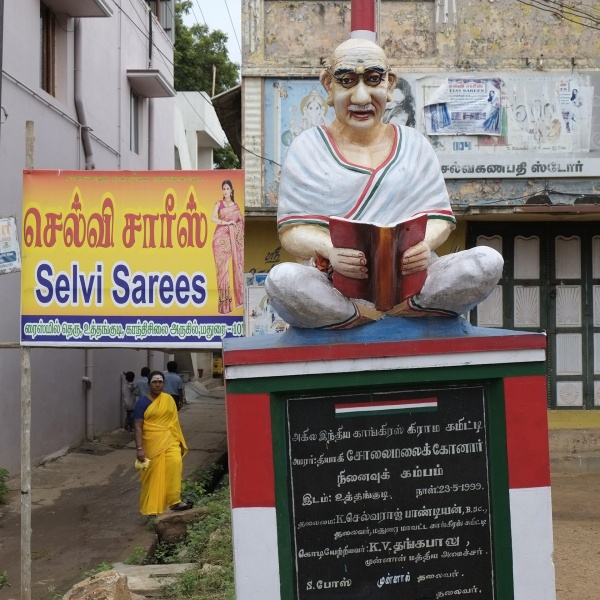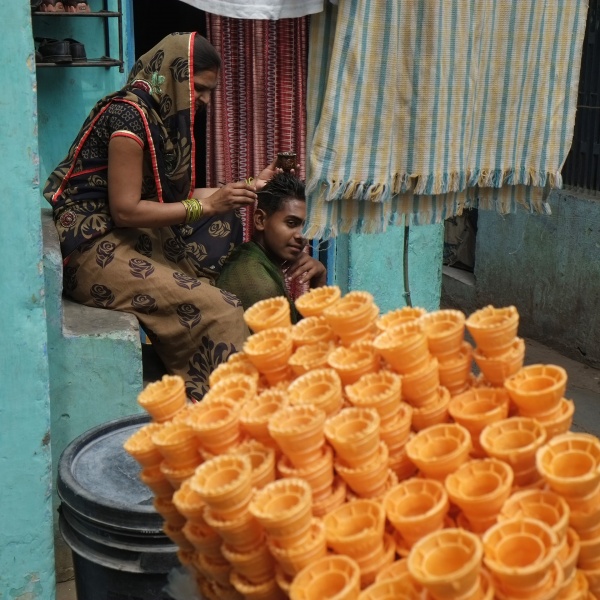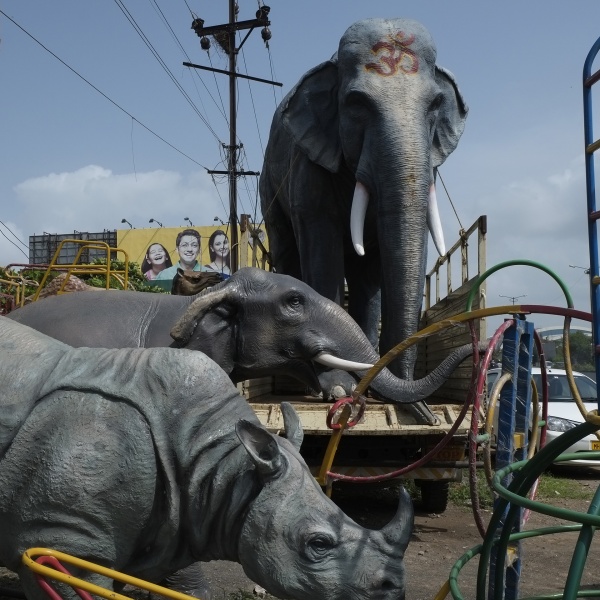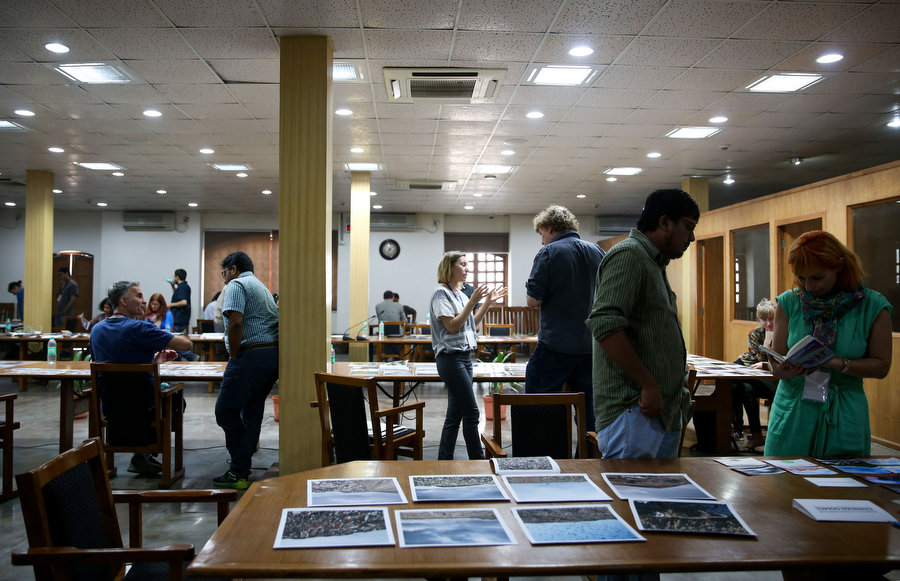
Portfolio reviews at the Delhi Photo Festival 2015. Photograph by Mansi Midha
Part 2: Times and Tides in the World of Photography
A frank interview with Prashant Panjiar, Delhi Photo Festival co-founder and World Press Photo 2016 Judge.
Continued from Part 1 of our interview with Prashant Panjiar.
In Ed Kashi’s recent public lecture in Singapore, he spoke about a “Manufactured Rift between Art and Journalism”. He expressed dismay at the art world’s rejection of photojournalism and its literalness in language. My personal observation is that the photojournalism world is equally dismissive of artspeak, which you kind of mentioned too earlier. You co-founded Delhi Photo Festival and curated Sensorium, a festival of arts, literature and ideas, so your insights on this would be valuable. What do you think about this?
And I’ve always been a photojournalist. I’m a hack. Haha. I think this issue of dismissiveness from both ends of the spectrum is not new. It’s been there for quite some time. The traditional idea is that art is created out of nothing other than imagination. Whereas photography and photojournalism is based on the idea of replicating something in real life, so therefore it cannot be art. There is no creation, you’re just photographing something that exists already. Now that’s just a stupid idea. It may have been relevant many, many years back. But media and mediums are changing, so these definitions can be thrown out the window. The fact is that there is this dismissiveness. And this is partly imposed by us, the photographers also, where we stick to our genres as being the most important aspect in defining who we are. I’m a photojournalist. I’m a fashion photographer. I’m a lifestyle photographer. I’m a street photographer. I’m this, I’m that. Fine. That’s something we do for a living. But for me, any work that is to become art has to transcend the time and the reason for why that image was made. Then it becomes art for me. If it is able to transcend that very moment, and the reason. So it’s no longer about this is a fashion picture. I mean why do we look at Helmut Newton’s work now? All of it was fashion, almost. And done for magazines. Because it’s actually about sexuality. It’s about exploring the idea of how people view their bodies and how they project their bodies. It’s no longer about fashion photography for me. That’s what makes it art. You no longer define the person as a fashion photographer or a landscape photographer. I think if you start doing that, some of these issues will go.
Not all of photojournalism or not all of photography is art. You know that. But if you transcend that moment… I mean look at Russian propaganda posters which were made for propaganda in Stalin’s period but today are preserved as art. Because they have a certain value beyond their time and their reason for making it. Or certain filmmakers’ work which were made for propaganda and now exists in archives of great cinema. So I think that is something that we need to recognise. And I think photographers need to recognise this primarily. I keep on saying that this debate of art versus photography and is photography an art form keeps happening all the time. For me personally, I feel that people that keep debating this are completely out of date, and I tell them to fuck off. I’m not interested in you. We do what we want to do. But this, photographers need to understand. And if they do, their work might actually improve because they’re no longer thinking about I’m doing a story for a magazine. It’s not about deforestation only but it’s about mankind, it’s about this or larger issues. And this makes the work live much longer. I don’t know if I answered your question. Haha. But it’s something I feel very strongly about.
So basically you are saying that whether something is art or not is a value given as opposed to made. That whether something stands the test of time is determined by audience and not the artist.
I think so. Let’s get rid of the debate of whether photography is art or not. That is a given. Photography is an art form. Right? Out the door. Now next, is photojournalism art? Are all photojournalism art? I don’t know. Just like every piece of sculpture made is not necessarily art. The process of making it may be artistic or whatever it is. But whether it will survive as art depends on whether it transcends the moment and the purpose for which it was made. So I may work on a story today on migration or a family that’s moving from one place to another, for a magazine. I’m dealing with a specific purpose at this particular time. My endeavour in that may be completely artistic. I hope so. But whether it will be accepted as art or not… If you as a viewer can see in it a larger thing outside of just that time and purpose of which that work was made will determine whether it is art or not. That’s what I think.
Well, this is a good entry point to the next question. There is a lot of talk of photography, art and creation today, moving away from objects. Some say it’s about experiences now, not objects, things. This inevitably makes craft tied to the object obsolete. One can attribute this to digital technology’s overwhelming penetration from computers to mobile devices. Images exist predominantly as a stream of bits and bytes. Author Sarah Thornton describes art today as more about Timeliness than Timelessness, which kind of ties back to what you just talked about.
There are a couple of different parts to this question. One has to do with the idea of moving away from the physicality of the image in current photography practice – all over, in all kinds of photography. Two, the idea that the craft itself being lost or not – because of the first reason and because of the digital era. And third, how the digital era determines what the nature of art is.
To answer the first part. I’ve encouraged the photojournalists that I speak with or mentor to actually move away from the physicality of the image. I mean, in the era or age where information is readily available, the reason for seeing an image is no longer for information. If it was just providing you the information that this man lived in a cave or forest, that’s not enough. You almost need to know through the picture why does he do it or how does he feel doing that. To be able to do that, the physicality of the image of just showing the man in the cave is not enough. You need to do something more than that. That’s one aspect. The other, a lot of writing in journalism, the earlier idea of journalism was that you have to be objective. Then a lot of writers started expressing opinions in their writing in mainstream news and stories. But photographers were still expected to be objective. So why not share your opinion of things? And that is something I would encourage photographers to do. So please express your opinion in your pictures. It’s no longer about being unbias. Moving away from the physicality of the image is something that is desirable I think, in a world where information is readily available.
Two. The craft. Since the digital age has made it easy to make an image, people think that the craft is not so important any more. Coupled with that, there are certain styles that have developed in photography that are stereotypes. Like the blank frontal gaze of the portrait; it’s very current. And we all started copying it. The square format, faded colours, landscape or industrial scapes that came from Europe which photographers from all over the world are copying. Or it’s this scratchy, out of focus, blur, movement et cetera which again, people are copying all the time. Some people do it well. These are all languages. If your language is not good, you won’t be able to tell a story. And so, craft is very important and some people don’t understand that. It’s not enough to have these blurry pictures and write a long artist statement about them. That’s bullshit you know. This is something that serious photographers really need to pay attention to. This is something we are losing – this idea of knowing your craft, knowing the language, learning your language well.
Now coming to the third part. The timeliness or timelessness in the digital age. It’s interesting. I think there was a study done on what kind of images people like on Facebook. As images become smaller because devices become smaller, you might find a change in the perception of what kind of images appeal to people. Again, the danger here is simplifying the image. Complex images with hidden information and all may not come through. I think Invisible Photographer Asia should do this study on Instagram or Facebook on how people react to this. I mean, yesterday I posted a picture from the ones I made at the Kumbh Mela in 2013. It’s a picture of these fibre-glass horses and one had fallen down. Now there’s a news report recently, just two days back, about a politician who in a riot, beat a horse and it fell down. It was a white horse. And today in the news, its leg had to be amputated. And that image because the horse is lying down with its leg broken is getting a huge amount of traffic. I mean a larger amount of traffic than my other images. Because people are immediately relating something else outside of that image to that. So this is a dynamic I don’t know about actually. What will be determined as art or appealing to people is still evolving. And I think that will be a fantastic issue for you to look into. Hahah.
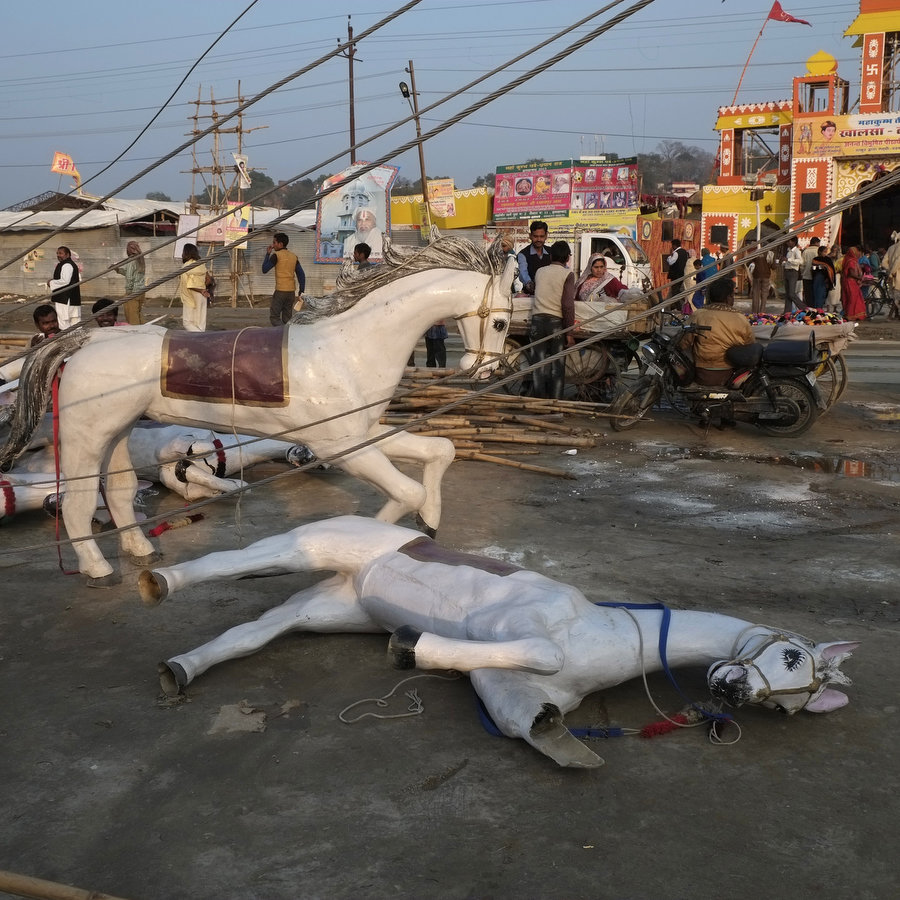
Kumbh Mela, Allhabad, 2013. Photograph by Prashant Panjiar
But when you posted that fallen horse image did you connect the dots beforehand?
No, I did not. I didn’t even think about it. You might post an image today in Singapore and it connects to something someone in the US is thinking about. And therefore it has traction. A small district or a town in US and it’s something that they’re thinking about. And suddenly you have two thousand likes on Instagram. Haha.
I like this quote from Rebecca Webb, Alex’s wife “Sometimes, my images are smarter than I am.” Okay, let’s move onto the next question. In Singapore, the market is dominant and affects and influences the environment and the conditions of creation. One might say that it’s a global trend. Do you agree? What is the case and context in India?
Obviously photographers have to earn a living. I’m gonna be shooting my mouth a bit here but I don’t mind. Haha. So there’s one part, the photography aspect of it. So many photographers, good photographers, are now moving towards also doing wedding photography. Because it pays the bills. Fortunately, and I’m saying fortunately because again, I’m putting my foot in my mouth here, the art print market happened for sometime in India and then fell by the wayside. Fortunately, because now people are not creating work just to sell in galleries. Because that becomes a really fraudulent process. But in terms of assignments, I might work for a non-profit or a newspaper or a fashion campaign for an ad client. So very much, the business of photography is definitely and completely controlled by the market. I mean there is no shying away from it. Does that leave space for doing personal work? That is the question you know.
But now coming back to what the long term impact of this is. Because one does not see it in photography but one sees it in the art world in India. And the art world in India is a very, very large world. Very dominant, internationally also. Almost all of us, whether it’s in photography or in the art world, are members of this establishment. We are not rebels. We are not the M.F. Hussains, the Razas of the fifties who were called the Bombay Progressive Artists Group. They were broke guys sitting in cafes sharing cups of tea and creating works. That was the dynamic that created work. Right now, almost every successful artist and photographer in India, including me, is very much part of the establishment. Now that, I think, is a problem. Are we ever going to create work that is challenging the system? I don’t know. And therefore, this tying to the market and measuring success in those terms may not be a good idea.
I’ve said it before, I really admire Sohrab (Hura). Here is an example of someone who is successful but that doesn’t necessarily translate into making money. And that puts him in a different league, in a different creation space. And I really value that. There are couple of other artists also. Successful, but have chosen to live in a different way and not be part of the establishment. If that does not happen, then you won’t get any work of any significance. I mean it will be nice work. I’m saying being socially conscious is a different thing. All of us are. And most Indian artists are really at the forefront of social consciousness and contribute that way. But still, we are part of the establishment. We are the elite in this country. So eventually what will happen? I don’t know.
But do you think it’s a global trend?
I don’t think so. Look at the West. I think it’s more a problem in Asia. I find successful artists there still lead a bohemian life. Out here, we need to get our car, our houses, our safe middle class, upper middle class lives. Isn’t that a fact?
So what does that say about us Asians then?
Haha. People talk about Indians and India being such spiritualists and a spiritual nation. And I say we are one of the most materialistic people in the world. Haha
Slideshow: INDIANISMS Photographs by Prashant Panjiar
Tell us about your own photography. Especially on “Indianisms” you’re currently working on.
My entry point to photography was through my interest in society, politics and culture. And social issues. I stuck with that right through my photojournalism. I didn’t do fashion, I didn’t do sports. I didn’t do wildlife. I worked on stories mostly with people from marginalised communities. Always. So in mid-2000s, it was kind of a logical conclusion for me and logical step for me to move into doing documentary work and working with non-profits. That was the time the magazines and newspapers started abandoning the stories and becoming more lifestyle products. It was the time I needed to move because I wasn’t getting the stories. I would get stories from international magazines to do on India’s rich and what the malls looked like. And I said screw it, this is not what I was interested in or what my training was.
Now in terms of my personal work, I don’t tend to work on “a project” as such. I have done in the past. But there’s always something in the back of my head spinning around. Some things that I’m seeing and reacting to, and I keep on shooting images of that as I travel, wherever. So actually if you look at it, it’s all single images. The last exhibition that I did was called Pan India, A Shared Habitat. In 2000, I started photographing with a panoramic camera because I wanted to find a new way of energising myself and getting out of the rut I was in. And it was the time when there was huge urbanisation and the idea of the global economy happening in India. In the back of my head, I was looking at a changing visual landscape in India. Wires running across, buildings, things happening, buildings being broken down; things I was interested in. In fact, a lot of artists were interested in that at the time too. And I kept shooting this and it was only after six years of this material in front of me – you know how shooting slides are, cutting the slides and putting them away and then five, six years later I start looking at them. Oh, there’s something there. It’s going somewhere. Then I would consciously work on it, creating the project.
The same thing with Indianisms. I’ve been interested in the idiosyncrasies of Indian life and looking at the vernacular kind of way of colour and the way that we do things, for quite some time. It’s an idea that has been brewing in my head and I’ve been photographing those. Probably when the project is finished you will find images that are twenty years old also. Four, five years back I moved to trying to shoot in the square format again because I get bored of myself. And that’s what you’re seeing now of these images. Now I know that it is a project. It might take a couple of years more until I’m ready. And that’s it.
Speaking of isms what about the recent discourse I read coming out of India on “Modi Ism”?
We have a right wing government in India. And the right wing has always been intolerant to liberal thinking. And art and literature are always the first targets of a right wing government. All around the world it seems like. I don’t know about Modi Ism, but there is a lot of intolerance in India right now. And it is of serious concern to all of us. I just saw in the morning today in the papers that two young people who did a cartoon on Facebook are being booked under some law I gather. Just because they are poking fun at a public person. And why can’t we? This is something of real concern to us. And something that we have to fight. There’s nothing else to it. Artists, writers and journalists will be targeted.
Tell us about your work at Nazar Foundation.
Nazar Foundation is just Dinesh Khanna and me. It started with the idea that we would do the Delhi Photo Festival and to do a festival you need a non-profit trust. And then we have expanded that work. We’re doing publishing now as you know. We do the Nazar Photography Monographs. Basically Dinesh and I work as photographers and Nazar Foundation is the work we do on a personal basis. But we need to codify it and make it sustainable because right now it is not sustainable. It’s the random whims and fancies of two people now.
I am aware of the Nazar monographs. So tell us about publishing photobooks and its current trend.
If you look at the three monographs that we have done you will find that we are moving in the direction the rest of us are. The first book was more like a traditional book. The second one was not. The third one now is more like an art object. Because of the way we find people buy the books. If we do a physical book, it has to be bought, otherwise there’s no point. The numbers, print run, that we have to do to make it work is shrinking. So, by the fourth book, we will be moving more consciously to the idea of the photobook as an art object. If it is not that there is no reason for people to buy it anymore. That seems to be what is happening. Paying attention to the craft involved in making the book will become very important along with the images in it. And of course it has to be in sync with the images and the subject matter, so it’s not just added on, for example, using hand-made paper just because it’s pretty. It has to be integral to the subject matter and core of the book. But without that, the reason for buying the photobook might be lost.
Is it a desirable thing? Definitely, because when you have a photobook that is an art object, it becomes that permanent exhibition of the photographer, in whatever limited number that may be. The next question would be do you do open or limited edition et cetera or how many editions do you do? Those are economic questions as well as artistic questions. But that’s definitely the way to go. I’m shifting house right now for example. All the books that I have collected over the years, many of them I am giving away. I don’t have space to take them with me. But I’m only keeping a little bit, the ones that I value. People talk about the coffee table book, but I would never want to do a coffee table book. Haha. Anymore. Ever. That used to be my ambition for sometime before but not anymore.
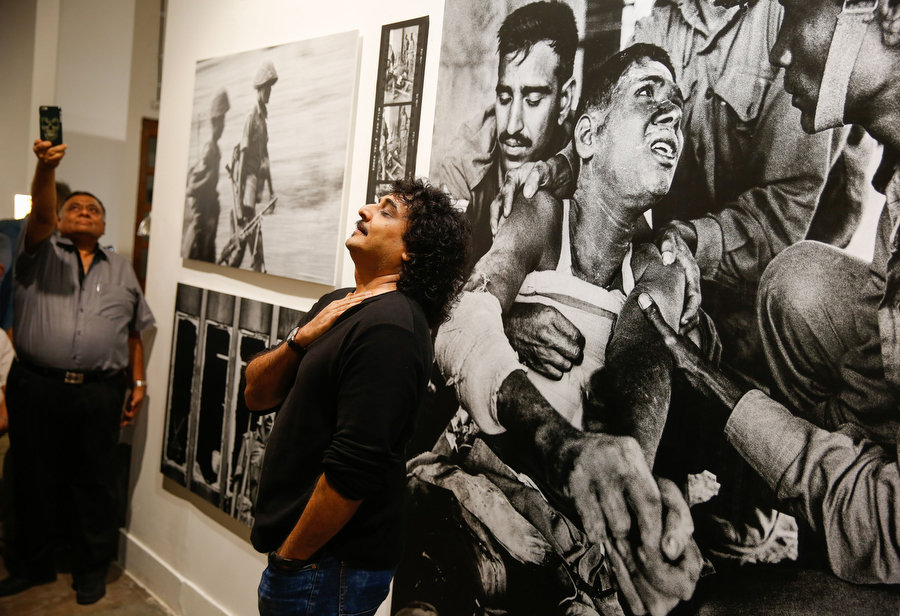
Swapan Parekh, son of the late Kishore Parekh, at his father’s exhibition “Bangladesh – A Brutal Birth” at the Delhi Photo Festival 2015.
Photograph by Mustafa Quraishi.
How was the response and take up been in India for the three books you published?
We have had a pretty good response to all the books. The second book by Adil Hasan: When Abba was ill has not sold as well as the first one or the third one. Because again, it’s a very personal work, it’s a very beautiful work. We always knew that this book would not do so well but that does not deter us from doing that book as produced in the way that it is beautiful. Over the years, people will value that book when they have it. So that’s one of the good things about being a non-profit. We know we don’t need to worry about making money. Haha. As long as one book pays for the other, it’s more than enough. So we have certain freedoms that commercial publishers don’t have. So we’ll continue to take our risks, but what will change is that we’ll no longer be thinking about print runs of 2,000 or 1,500. It’s out of the question. Just not able to sell those books at those numbers.
So what was the run for each of the three books?
First one was 1,000. Second one was 700. The third one was 1,500 but 500 went to sponsors. We’ll be looking at 500 or 700 now onwards.
If you had an opportunity to curate a small show of young Indian photographers, what would be some names that come to mind?
That would be interesting. In fact, I am working on a festival at the end of the year in Goa. It’s called Serendipity Arts Festival. A visual arts and performing arts festival. In fact, if you are free you should come for that. It will be interesting. Dinesh and I are curating the photography part of it. There are twelve curators. So I am looking at work right now. I’ll give you one name right now. Prashanth Vishwanata. Lot of images. He has worked in media and all. I just met him recently and he is trying to figure out where is that one body of work. It’s that discovery of finding a thread somewhere. If I told you I’m working on a project, you know it will be a project. So you can take a project and curate it in a certain way. But to find a huge amount of work from somebody and then find patterns and that and all, it’s interesting and exciting. I think Prashanth will be a good example to look at.
More often then not, people behind the scenes aren’t acknowledged as much. Photographers and the work are usually what’s in the frontline. We’ve been doing Invisible Photographer Asia for quite a while now. There’s always some good people behind the scenes, such as yourself, we don’t really see or hear about. I’ve heard many good things about you and your relationship with the younger generation of photographers in India. What keeps you going? How do you approach or advise the next generation, especially in today’s world where there seems to be uncertainty and a rationalising process at play?
I ask myself the question also – why do I do this? There are a couple of reasons. One of them is that when I was starting out in photography, when I worked as a photographer full-time in magazines and newspapers, there were many things that I missed which I felt I should have had… ability to work on long-term projects et cetera et cetera. So to have the opportunity to make amends or to provide to what I missed out on is why I do this… The festival whether it succeeds or not, the mentoring of a grant for photography… and I still drive myself to do it because it is something that I would have wanted for myself. I generally get a rush. I miss working in the newspapers. The rush of chasing a story and getting it done, fighting the odds, and getting your film back from some warzone, and without the censors getting to it and all that. That’s all part of it. So I enjoy the rush of doing these things, the festival or building something, especially when it is difficult. If it is easy it is no fun. So that’s on the personal side.
On the other side, for the photographers that I mentor or whatever it is, I’ve been telling them that look you need to diversify. If you think you will make a living only being a photographer working in photojournalism, then it’s a pipe dream. It’s not going to happen. You will not make enough money. So you will have to be able to leverage what you have; the skills that you have. In today’s world, to be able to do a multitude of things without getting distracted so to speak. I don’t tell people to be a purist and not do commercial work or not to do wedding photography. Do it. Or if someone has a skill to actually be a curator and not necessarily only a photographer, I will tell that person please think about this. And help them to be a curator. One of the things that again, the Delhi Photo Festival tries to do is to create teachers, tutors and curators from within our ranks rather than rely on established names and bringing them in. I think that’s a worthwhile thing to do.
And for me, I’m a photographer. I’m a curator. And I’m a visual communications consultant. I make my money from various things and that gives me the freedom to do certain things. And that’s something photographers have to realise. The olden days where you could say I’m just a photojournalist and I work on assignments for Time Magazine or Life Magazine or a good newspaper… I worked in India Today for ten years and I got the best stories to do. But today, most people who work in newspapers or magazines are not able to go outside their own cities. They will not send them because there’s no money. So it’s a different world. And with the web and self-publishing, you are your own entrepreneur. I think that’s the recognition we have to come to.
This interview was conducted with Kevin WY Lee over Skype. This transcript has been edited for length and clarity.
Read Part 1 of our Interview with Prashant Panjiar.
Read more exclusive interviews: https://invisiblephotographer.asia/category/invisible-interviews/
Share

